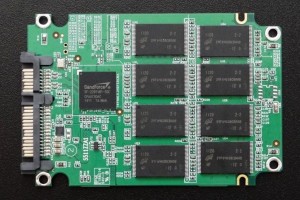The front of the Force Series GT PCB displays the SandForce SF-2281 processor which is proving to be the hottest thing in solid state drives these days. There is not a company around that has moved to SATA 3 and not shaken hands with SandForce in some way, shape or form. In fact, I only know of one SSD manufacturing company (who happens to also be the worlds largest technological entity) that I cannot tie into SandForce whatsoever.

 Also visible on each side of the PCB are 8 modules of Micron 25nm synchronous NAND flash memory (29F64G08CBAAB). This caused a bit of confusion at first because another reviewer had printed there to be Toshiba Toggle Mode flash within so I am curious as to whether Corsair elected to utilize Toshiba for their 240GB version while Micron remains for our Force GT 120GB.
Also visible on each side of the PCB are 8 modules of Micron 25nm synchronous NAND flash memory (29F64G08CBAAB). This caused a bit of confusion at first because another reviewer had printed there to be Toshiba Toggle Mode flash within so I am curious as to whether Corsair elected to utilize Toshiba for their 240GB version while Micron remains for our Force GT 120GB.
Memory is the key difference between the Force GT and Force Series 3 as the Series 3 utilizes Micron 25nm asynchronous NAND flash whereas the GT uses synchronous NAND flash memory. Each memory chip is 8GB in capacity for a total of 128GB, however one module is dedicated to SandForce over provisioning and firmware needs which reduces capacity to 120GB. Formatting of the GT then results in 112GB storage capacity available to the user.
 Asynchronous NAND flash memory is relatively new to the world of consumer SSDs and we first saw it with the OCZ Agility and now recognize its appearance in the Force Series 3. Asynchronous memory is much cheaper than the synchronous flash utilized in the Force GT and async NAND now provides us with a more cost effective consumer solution in SSD migration.
Asynchronous NAND flash memory is relatively new to the world of consumer SSDs and we first saw it with the OCZ Agility and now recognize its appearance in the Force Series 3. Asynchronous memory is much cheaper than the synchronous flash utilized in the Force GT and async NAND now provides us with a more cost effective consumer solution in SSD migration.
The downfall, of course, is performance where async memory does not handle incompressible data very well at all.
- The Corsair Force GT performs much better than the Force Series 3 although both are SATA 3;
- The Corsair Force Series 3 has a significantly lower price point than the Force GT at the same capacity.
TEST BENCH AND PROTOCOL
 We have to apologize up front because our Test Bench is going through a bit of a transition but we thought it beneficial to throw in a picture in any case. A simple click will enlarge it to assist.
We have to apologize up front because our Test Bench is going through a bit of a transition but we thought it beneficial to throw in a picture in any case. A simple click will enlarge it to assist.
Our main goal in testing is to ensure that all test results are as accurate as they can be and no anomalies slip through.
We conduct all tests three times and, if necessary, we may conduct specific tests in Windows 7 ‘safe mode’ to ensure the OS has little to no influence on the end result.
We prefer to use as many benchmark programs as possible to assist with confirmation of results and provide the reader with the actual tests as received to avoid any confusion when unexpected test benchmarks are received.
SSD COMPRESSION AND TESTING FLUCTUATIONS
All SSDs are not created equal and many new SSD enthusiasts realize that when they test their new drive to confirm specifications and ensure all is in order. SandForce controlled SSDs, as in the Corsair Force Series GT we are testing today, use compression techniques in storage whereas many others do not. This creates a bit of confusion when enthusiasts test the drive with random data through benchmarking programs such as AS SSD and Crystal Diskmark (random data sample). The results seem to be lower than the listed specifications.
The results actually present a false portrayal of the drives ability when compared to other drives such as Samsung, Crucial or Intel. It is for this reason that all of our comparison testing is done traditionally through PCMark Vantage. PCMark Vantage HDD Suite simply provides evaluation results based on transfer speeds reached through typical user patterns. Vantage provides a better testing medium, in that, it sees through the typical synthetic benchmarks and provides us with ‘true to life’ results of the drive.
BENCHMARK SOFTWARE
Software used for testing by The SSD Review consists of Crystal DiskMark, HDTune Pro, AS SSD, ATTO Benchmark along with FutureMark PCMark Vantage. We are going to give you a bit of a treat as well by giving you a peak of new software that we are presently Beta testing called Anvil Storage Utilities Professional Edition.
All do a great job of showing us the numbers that we want to see, or dont want to see in some cases, while PCMark Vantage x64 is an excellent program which recreates tests that mimic the average users activity, all the while providing a medium to measure each.
INDEX
Page 1 – Introduction and Exterior Packaging
Page 2 – Interior Components & Test Protocol
Page 3 – Data Types, ATTO and Crystal DiskMark Testing
Page 4 – AS SSD and Anvil Storage Utilities Benchmarks
Page 5 – HDTune Pro Testing
 The SSD Review The Worlds Dedicated SSD Education and Review Resource |
The SSD Review The Worlds Dedicated SSD Education and Review Resource | 